Table of content
Crispy pork hocks in sour soup, a dish that tantalizes the taste buds with its contrasting textures and bold flavors, is a culinary masterpiece rooted in Chinese gastronomy. This recipe combines the richness of tender pork, the satisfying crunch of perfectly fried skin, and the vibrant tang of a meticulously crafted sour broth. Whether you are a seasoned home cook or a curious food enthusiast, this guide will walk you through the intricacies of creating this iconic dish, ensuring every bite delivers a symphony of umami, acidity, and spice.
Understanding the Dish
Crispy pork hocks in sour soup, known in Mandarin as cuì pí suān tāng zhū jiǎo, is a beloved staple in regions like Yunnan and Guizhou, where the use of fermented ingredients and aromatic herbs elevates simple proteins into feasts for the senses. The dish’s appeal lies in its duality: the pork hocks are first simmered until tender, then fried to achieve a glass-like crispiness, before being submerged in a broth brimming with sour notes from tomatoes, vinegar, and fermented chili paste. The result is a harmonious blend of textures and flavors that is both comforting and invigorating.
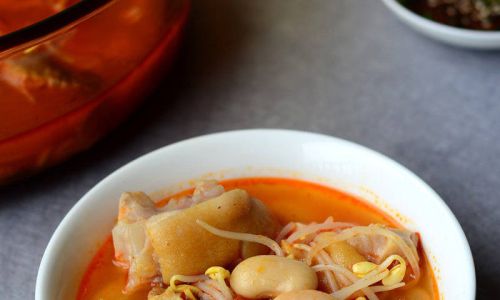
Ingredients: Assembling the Building Blocks
To embark on this culinary journey, gather the following ingredients, each playing a pivotal role in the dish’s character:
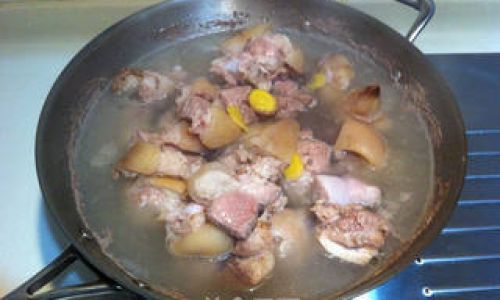
For the Pork Hocks
- 4 pork hocks (front or hind legs), approximately 1.5 kg each
- 2 tablespoons cooking oil (for parboiling)
- 1 tablespoon salt
- 1 tablespoon white pepper
- 500 ml vegetable oil (for deep-frying)
For the Sour Broth
- 4 ripe tomatoes, diced
- 3 tablespoons tomato paste
- 100 ml rice vinegar (or Chinese black vinegar)
- 50 ml fermented chili bean paste (doubanjiang)
- 8 cups chicken or pork stock
- 1 large onion, finely chopped
- 6 garlic cloves, minced
- 3-inch piece of ginger, grated
- 2 star anise pods
- 1 cinnamon stick
- 1 teaspoon Sichuan peppercorns
- 3 bay leaves
- 2 tablespoons soy sauce
- 1 tablespoon sugar
- 4-6 dried red chilies (optional, for heat)
- 2 tablespoons fresh cilantro, chopped (for garnish)
- 4 green onions, sliced (for garnish)
For the Marinade (Optional)
- 3 tablespoons light soy sauce
- 2 tablespoons Shaoxing wine
- 1 tablespoon five-spice powder
Preparation: Laying the Foundation
Preparing the Pork Hocks
- Cleaning and Parboiling: Rinse the pork hocks under cold water to remove any impurities. Place them in a large pot, cover with water, and bring to a boil. Add 1 tablespoon of cooking oil to help reduce scum. Skim off any foam that rises to the surface. Reduce the heat to a simmer and cook for 30 minutes. This step tenderizes the meat and removes excess fat.
- Marinating (Optional): For deeper flavor, drain the hocks and rub them with a mixture of soy sauce, Shaoxing wine, and five-spice powder. Let them marinate for at least 2 hours, or overnight in the refrigerator.
Crafting the Sour Broth Base
- Sautéing Aromatics: In a large stockpot, heat 2 tablespoons of cooking oil over medium heat. Add the onions, garlic, and ginger, sautéing until fragrant and golden. Stir in the tomato paste and fermented chili bean paste, cooking for 2-3 minutes to mellow their raw edges.
- Building Flavor: Toss in the diced tomatoes, star anise, cinnamon, Sichuan peppercorns, and bay leaves. Sauté until the tomatoes soften and release their juices. Pour in the stock, soy sauce, sugar, and rice vinegar. Bring the mixture to a gentle simmer, then reduce the heat to low. Let it bubble gently for 45 minutes to allow the spices to meld.
Cooking Process: Achieving Perfection
Crisping the Pork Hocks
- Drying: After parboiling, pat the hocks dry with paper towels. Ensure they are completely dry to prevent oil splatters during frying.
- Deep-Frying: Heat the vegetable oil in a deep fryer or heavy-bottomed pot to 180°C (350°F). Carefully lower the hocks into the oil, skin-side down. Fry for 8-10 minutes, turning occasionally, until the skin puffs up and turns golden brown. Use a splatter screen to protect yourself from hot oil.
- Resting: Transfer the fried hocks to a wire rack to drain excess oil. Let them rest for 10 minutes before slicing. This ensures the skin remains crispy.
Assembling the Dish
- Slicing the Hocks: Using a sharp knife, cut the hocks into 2-inch thick slices, exposing the tender meat and crispy skin.
- Simmering in Broth: Gently place the sliced hocks into the simmering sour broth. Ensure they are submerged but not crowded. Simmer for an additional 15-20 minutes to allow the flavors to penetrate the meat.
- Adjusting Seasoning: Taste the broth and adjust with salt, sugar, or vinegar as needed. The broth should balance tanginess, spice, and savory depth.
Serving Suggestions: Elevating the Experience
- Presentation: Ladle the pork hocks and broth into deep bowls. Garnish generously with cilantro, green onions, and a drizzle of chili oil for those who crave heat.
- Accompaniments: Serve with steamed jasmine rice, egg noodles, or a side of pickled vegetables to cut through the richness.
- Beverage Pairing: A crisp lager, light riesling, or chrysanthemum tea complements the dish’s acidity and spice.
Variations and Tips
- Protein Swap: Substitute pork hocks with chicken thighs or duck legs for a lighter variation. Adjust cooking times accordingly.
- Vegetarian Twist: Use firm tofu or wheat gluten (seitan) marinated in soy sauce and smoked paprika, then fried until crispy.
- Spice Level: Control the heat by omitting dried chilies or adding fresh jalapeños during service.
- Make-Ahead: The broth can be prepared a day in advance and refrigerated. Reheat gently before adding the fried hocks.
Troubleshooting Common Pitfalls
- Soggy Skin: Ensure the hocks are completely dry before frying. Fry at the correct temperature to prevent oil absorption.
- Bland Broth: Roast the tomatoes and aromatics before adding stock to deepen flavor.
- Overcooked Meat: Parboil just until tender; overcooking will result in mushy texture.
Cultural Significance
This dish embodies the philosophy of yīn yáng in Chinese cuisine—the balance of opposing forces. The crispy, fatty pork hocks represent yang (vigor), while the sour, aromatic broth embodies yīn (calmness). Historically, such dishes were prepared for festivals and gatherings, symbolizing prosperity and togetherness.
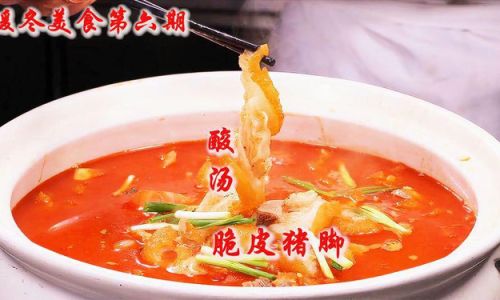
Conclusion
Crafting crispy pork hocks in sour soup is a labor of love that rewards patience and precision. Each step—from parboiling to frying, from simmering to seasoning—contributes to a dish that is both humble and extraordinary. Whether enjoyed on a chilly evening or shared at a festive table, this recipe invites you to savor the alchemy of flavors that have delighted generations. So, don your apron, gather your ingredients, and let the sizzle of the wok and the aroma of spices transport you to the heart of Chinese culinary tradition.




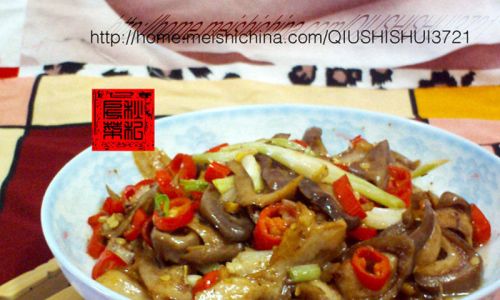
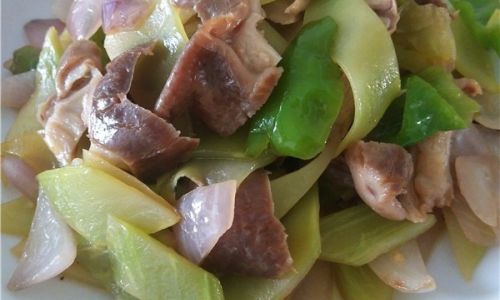
0 comments